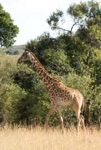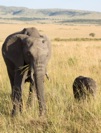kenyaView








Savannah Ecology 5/5: How the savannah ecosystem fits together.
The sun, the rain and the soil produce grass, shrubs and trees.
Herbivores eat the grass and plants. Some herbivores are grazers, eating grass, and others browsers, eating leaves, while some are mixed. Different herbivores specialise in different plants. In addition, some animals which eat the same plant may do so in different ways: some eat only the top part of the grass, while leaving the lower part for other animals, for example. Many birds, of course, are also herbivores, eating seeds.
Herbivores die, or are killed, and are eaten by carnivores and other animals. Lions and other cats, hyaenas and so on are typical carnivores, but some research suggests that more meat is actually eaten by vultures and other birds than by mammals. And of course some insects and their offspring eat meat, too. And there are crocodiles. When carnivores die, they are eaten by other carnivores, or dissolve back into the earth.
Some insects, such as grasshoppers, also eat plants, and some birds eat the insects. If there were no termites, then the plain would be covered with dead wood and grass. Termites' digestive systems have bacteria like those in the gut of mammalian herbivores which means they can digest cellulose. They clean up the savannah, and when they die, they fertilize it with complex materials. And 'Anteaters' eat termites directly.
If there were no beetles, the savannah would be covered with dung. Beetles recover remaining digestible material from the waste products of higher animals. Dead animals and plants enrich the soil, and with the addition of sunshine and rainwater restart the process.
There are also people and their domesticated animals: the Maasai.













